Blog & Latest Updates
Fly Fishing Articles
Insects by Common Name


Mayfly Family Heptageniidae (March Browns, Cahills, Quill Gordons)
Taxonomic Navigation -?-
Kingdom
Animalia (Animals)
» Phylum
Arthropoda (Arthropods)
» Class
Insecta (Insects)
» Order
Ephemeroptera (Mayflies)
» Family Heptageniidae (March Browns, Cahills, Quill Gordons)
4 genera aren't included.
Common Name
| Match | Common Name |
| March Browns, Cahills, Quill Gordons |
This is page 14 of specimens of Heptageniidae. Visit the main Heptageniidae page for:
- The behavior and habitat of Heptageniidae.
- 11 underwater pictures of Heptageniidae.
Pictures of 215 Mayfly Specimens in the Family Heptageniidae:
Rhithrogena Mayfly Nymph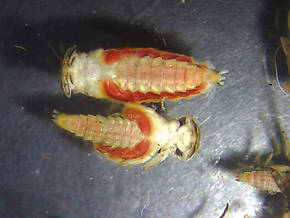 View 1 PicturesNote the unusual red coloration of these Rhithrogena nymphs.
View 1 PicturesNote the unusual red coloration of these Rhithrogena nymphs.
 View 1 PicturesNote the unusual red coloration of these Rhithrogena nymphs.
View 1 PicturesNote the unusual red coloration of these Rhithrogena nymphs.Female Epeorus longimanus (Slate Brown Dun) Mayfly Spinner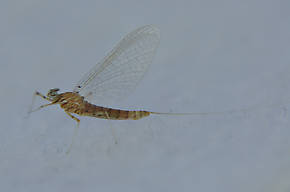 View 1 PicturesI associated this female with a male I collected one night later. For a great and informative discussion of all Epeorus species and other mayflies be sure and read, WESTERN MAYFLY HATCHES by R. Hafele and D. Hughes. They rate all of the western mayflies and they rate the hatch of this genus a 25 out of a possible 45 points based on several rating criterion. They provide insect photos, possible fly patterns and fly presentations. This is a great book.
View 1 PicturesI associated this female with a male I collected one night later. For a great and informative discussion of all Epeorus species and other mayflies be sure and read, WESTERN MAYFLY HATCHES by R. Hafele and D. Hughes. They rate all of the western mayflies and they rate the hatch of this genus a 25 out of a possible 45 points based on several rating criterion. They provide insect photos, possible fly patterns and fly presentations. This is a great book.
 View 1 PicturesI associated this female with a male I collected one night later. For a great and informative discussion of all Epeorus species and other mayflies be sure and read, WESTERN MAYFLY HATCHES by R. Hafele and D. Hughes. They rate all of the western mayflies and they rate the hatch of this genus a 25 out of a possible 45 points based on several rating criterion. They provide insect photos, possible fly patterns and fly presentations. This is a great book.
View 1 PicturesI associated this female with a male I collected one night later. For a great and informative discussion of all Epeorus species and other mayflies be sure and read, WESTERN MAYFLY HATCHES by R. Hafele and D. Hughes. They rate all of the western mayflies and they rate the hatch of this genus a 25 out of a possible 45 points based on several rating criterion. They provide insect photos, possible fly patterns and fly presentations. This is a great book.Collected July 24, 2011 from the Touchet River in Washington
Added to Troutnut.com by Bnewell on July 25, 2011
Added to Troutnut.com by Bnewell on July 25, 2011
Ecdyonurus criddlei (Little Slate-Winged Dun) Mayfly Nymph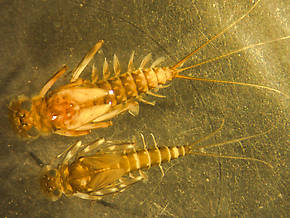 View 1 PicturesThis is an interesting Heptageniid mayfly since in western Montana it is only found in cold lakes, especially those in Glacier National Park.
View 1 PicturesThis is an interesting Heptageniid mayfly since in western Montana it is only found in cold lakes, especially those in Glacier National Park.
 View 1 PicturesThis is an interesting Heptageniid mayfly since in western Montana it is only found in cold lakes, especially those in Glacier National Park.
View 1 PicturesThis is an interesting Heptageniid mayfly since in western Montana it is only found in cold lakes, especially those in Glacier National Park.Collected July 31, 2007 from Kintla Lake in Montana
Added to Troutnut.com by Bnewell on June 26, 2011
Added to Troutnut.com by Bnewell on June 26, 2011
Male Rhithrogena hageni (Western Black Quill) Mayfly Spinner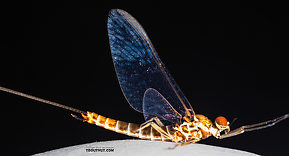 View 14 PicturesAlthough I could not find the preserved specimen to examine under my good new microscope, I'm tentatively calling it one Rhithrogena hageni, based on apparent similarity to this specimen, which I was able to positively ID.
View 14 PicturesAlthough I could not find the preserved specimen to examine under my good new microscope, I'm tentatively calling it one Rhithrogena hageni, based on apparent similarity to this specimen, which I was able to positively ID.
The relative angle of the penes (Penes: The paired genital structures of most male insects, which vary widely in form and are one of the main characteristics used for species identification.) is a bit shallower in this specimen, but I photographed another specimen from the same collecting trip (and I think even the same swarm, although I don't recall for sure) as the other one, and it had the shallower angle seen on this specimen. I'm guessing it's just variation within the species.
 View 14 PicturesAlthough I could not find the preserved specimen to examine under my good new microscope, I'm tentatively calling it one Rhithrogena hageni, based on apparent similarity to this specimen, which I was able to positively ID.
View 14 PicturesAlthough I could not find the preserved specimen to examine under my good new microscope, I'm tentatively calling it one Rhithrogena hageni, based on apparent similarity to this specimen, which I was able to positively ID. The relative angle of the penes (Penes: The paired genital structures of most male insects, which vary widely in form and are one of the main characteristics used for species identification.) is a bit shallower in this specimen, but I photographed another specimen from the same collecting trip (and I think even the same swarm, although I don't recall for sure) as the other one, and it had the shallower angle seen on this specimen. I'm guessing it's just variation within the species.
Collected July 8, 2019 from the Ruby River in Montana
Added to Troutnut.com by Troutnut on July 18, 2019
Added to Troutnut.com by Troutnut on July 18, 2019
Female Maccaffertium terminatum Mayfly Spinner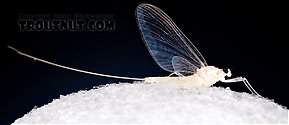 View 5 PicturesI was able to identify this female because I captured her while she was mating with an identifiable male.
View 5 PicturesI was able to identify this female because I captured her while she was mating with an identifiable male.
 View 5 PicturesI was able to identify this female because I captured her while she was mating with an identifiable male.
View 5 PicturesI was able to identify this female because I captured her while she was mating with an identifiable male.Collected June 7, 2007 from the West Branch of the Delaware River in New York
Added to Troutnut.com by Troutnut on June 8, 2007
Added to Troutnut.com by Troutnut on June 8, 2007
Cinygmula (Dark Red Quills) Mayfly Nymph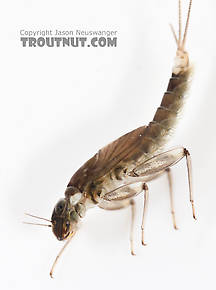 View 8 PicturesThis nymph was one of many I collected with vivid white or semi-transparent markings on the front of the head, the sides of the pronotum (Pronotum: The top of the insect prothorax.), and the last abdominal segments.
View 8 PicturesThis nymph was one of many I collected with vivid white or semi-transparent markings on the front of the head, the sides of the pronotum (Pronotum: The top of the insect prothorax.), and the last abdominal segments.
 View 8 PicturesThis nymph was one of many I collected with vivid white or semi-transparent markings on the front of the head, the sides of the pronotum (Pronotum: The top of the insect prothorax.), and the last abdominal segments.
View 8 PicturesThis nymph was one of many I collected with vivid white or semi-transparent markings on the front of the head, the sides of the pronotum (Pronotum: The top of the insect prothorax.), and the last abdominal segments.Collected July 17, 2011 from the Gulkana River in Alaska
Added to Troutnut.com by Troutnut on July 20, 2011
Added to Troutnut.com by Troutnut on July 20, 2011
Cinygmula (Dark Red Quills) Mayfly Nymph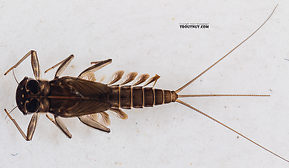 View 7 Pictures
View 7 Pictures
 View 7 Pictures
View 7 PicturesCollected July 28, 2019 from Mystery Creek #199 in Washington
Added to Troutnut.com by Troutnut on July 30, 2019
Added to Troutnut.com by Troutnut on July 30, 2019
Male Maccaffertium terminatum Mayfly Spinner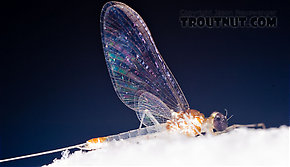 View 11 PicturesI positively identified this specimen under a microscope with a good key. It was one of the more common species in a generally light mixed bag of mayflies over a big Catskill tailwater last night.
View 11 PicturesI positively identified this specimen under a microscope with a good key. It was one of the more common species in a generally light mixed bag of mayflies over a big Catskill tailwater last night.
I swooped this one out of the air while it was mating with a female, so I can be certain about her ID as well.
 View 11 PicturesI positively identified this specimen under a microscope with a good key. It was one of the more common species in a generally light mixed bag of mayflies over a big Catskill tailwater last night.
View 11 PicturesI positively identified this specimen under a microscope with a good key. It was one of the more common species in a generally light mixed bag of mayflies over a big Catskill tailwater last night.I swooped this one out of the air while it was mating with a female, so I can be certain about her ID as well.
Collected June 7, 2007 from the West Branch of the Delaware River in New York
Added to Troutnut.com by Troutnut on June 8, 2007
Added to Troutnut.com by Troutnut on June 8, 2007
Heptagenia pulla (Golden Dun) Mayfly Nymph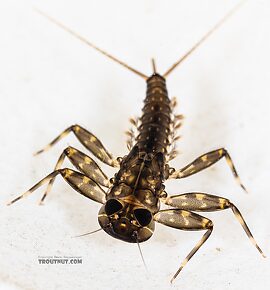 View 11 PicturesThis specimen is interesting because Heptagenia pulla has not been reported from Washington or neighboring states (Saskatchewan is the closest), yet the distinctive key characteristics are clear.
View 11 PicturesThis specimen is interesting because Heptagenia pulla has not been reported from Washington or neighboring states (Saskatchewan is the closest), yet the distinctive key characteristics are clear.
It keys to the genus Heptagenia because the tarsal claw (Tarsal claw: The claws at the tip of the tarsus, on an insect's "foot.") has a single basal (Basal: close to the base; root or beginning) tooth, and the gills on segment 7 have fibrils.
For the species key:
1. The left mandible (Mandible: The paired jaws of an insect which are used for grabbing food, located immediately behind the labrum.) is planate (fairly straight-edged) whereas the right mandible (Mandible: The paired jaws of an insect which are used for grabbing food, located immediately behind the labrum.) is angulate (has one sharp turn on the edge).
2. The labrum (Labrum: The platelike structure forming the roof of the mouth of insects; the upper lip.) is much wider than long.
3. There's a thin light-colored streak lateral (Lateral: To the side.) to the eye on the head.
 View 11 PicturesThis specimen is interesting because Heptagenia pulla has not been reported from Washington or neighboring states (Saskatchewan is the closest), yet the distinctive key characteristics are clear.
View 11 PicturesThis specimen is interesting because Heptagenia pulla has not been reported from Washington or neighboring states (Saskatchewan is the closest), yet the distinctive key characteristics are clear.It keys to the genus Heptagenia because the tarsal claw (Tarsal claw: The claws at the tip of the tarsus, on an insect's "foot.") has a single basal (Basal: close to the base; root or beginning) tooth, and the gills on segment 7 have fibrils.
For the species key:
1. The left mandible (Mandible: The paired jaws of an insect which are used for grabbing food, located immediately behind the labrum.) is planate (fairly straight-edged) whereas the right mandible (Mandible: The paired jaws of an insect which are used for grabbing food, located immediately behind the labrum.) is angulate (has one sharp turn on the edge).
2. The labrum (Labrum: The platelike structure forming the roof of the mouth of insects; the upper lip.) is much wider than long.
3. There's a thin light-colored streak lateral (Lateral: To the side.) to the eye on the head.
Collected April 9, 2021 from the Yakima River in Washington
Added to Troutnut.com by Troutnut on April 12, 2021
Added to Troutnut.com by Troutnut on April 12, 2021
Maccaffertium (March Browns and Cahills) Mayfly Nymph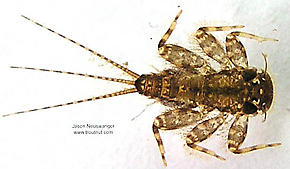 View 4 Pictures
View 4 Pictures
 View 4 Pictures
View 4 PicturesCollected January 12, 2004 from unknown in Wisconsin
Added to Troutnut.com by Troutnut on January 25, 2006
Added to Troutnut.com by Troutnut on January 25, 2006
Top 10 Fly Hatches
Top Gift Shop Designs
Eat mayflies.
Top Insect Specimens
Miscellaneous Sites
Troutnut.com is copyright © 2004-2024 Jason
Neuswanger (email Jason). See my FAQ for information about use of my images.
 privacy policy
privacy policy
